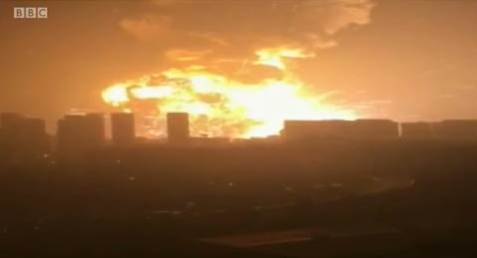By Clément Paule
Translation: Lea Sharkey
Passage au crible n° 136
 Source: BBC
Source: BBC
On the evening of August 12, 2015, a blast shook off Tianjin City, the fourth most populated urban area of the People’s Republic of China. According to Chinese media, the incident had been caused by accidental fire of a storage station containing ethanol and alcohol based products. It is not the first time the 15-million metropolis, located in North-West China and one hundred kilometers away from capital Beijing, faces that kind of event. Two months earlier, a series of huge explosions destroyed the Binhai port area and adjoining residential zones, resulting in 173 killed and about 700 injured.
The disaster originates from a warehouse, property of the Chinese company Rui Hai Logistics, where large quantities of hazardous chemical products were being stored. In this case, media mentioned that several hundreds of tons of sodium cyanide – used in gold mining exploitation – were stored in the warehouse, exposing the population to major water and air pollution risks. This is why Chinese authorities issued an evacuation order concerning 6000 residents and launched large scale cleaning operations. According to Press agency Xinhua, 17 000 households and 1700 companies overall were affected by these events, while a study carried out by Crédit Suisse assesses the damages to 1.3 billion dollars.
> Historical background
> Theoretical framework
> Analysis
> References
Historical background
Some elements related to the country’s recent history may set the context. The situation is still marked by ongoing economic slowdown with growth figures increasingly called into question, whilst the government has devaluated the Yuan twice. On a political level, we may highlight the intensification of anti-corruption measures driven by First Secretary Xi Jinping that resulted in the arrest of several CCP leaders (Chinese Communist Party). Some authors, such as sinologist Jean-Pierre Cabestan, outline an increasing militarisation of the regime coping with the downturn of the leading model pushed forward since the 80’. On top of this, a series of major industrial disasters occurred such as the August 2014 explosion of an automotive parts manufacturer in Kunshan (146 victims), or the deadly fire of a slaughterhouse in 2013 in the Jilin Province. In this regard, NGO (Non Governmental Organisation) China Labour Bulletin has recorded more than three hundred similar accidents causing death of several hundreds of workers since late 2014.
In this context, the Tianjin Township has a strategic role given its location as maritime entrance of capital Beijing and as international hub for transportation and logistics. Some 540 million tons of material transit every year, placing Tianjin in the international ports top ten. Close to the central government, the city experienced an unprecedented growth in the last decades, enough to be nicknamed “The New Manhattan”. Indeed, special economic zone Binhai showcases technological innovation in aeronautics, electronics, petrochemicals or pharmaceutics. Estimated to 143 billion dollars in 2014, its GDP (Gross Domestic Product) increased by 15,5%, more than the double of national average. This outstanding economic take-off has given rise to chaotic urbanisation and environmental damages caused by frenzy industrialisation over the last three decades. The disaster of August 12, 2015 strikes at the core of the system and highlights the paradox of frantic modernisation.
Theoretical framework
1.The “black hole” of globalisation. Industrial insecurity brought to light by this incident is due to systematic bypass of economic regulations. Moreover, collusion capitalism or crony capitalism operating at the heart of the Chinese regime creates unregulated zones or black holes (Susan Strange) eventually jeopardising its authority.
2. Selective liability. Facing this complex crisis, the government relies on solutions applied to previous disasters, such as the 2008 Sichuan earthquake. Besides controlling information streams, culprits are identified and held responsible for the failure of the whole political and administrative system.
Analysis
Several investigations regarding the catastrophe rapidly revealed a series of infringements to current regulations, in spite of recent strengthening of existing legislation. The devastated warehouse contained 40 times the legal limit of sodium cyanide, stored without any legal operating permits. Moreover, the first residential buildings were only 600 meters away from the site of the explosion, well underneath the legal threshold of 1 km. It is to be noted that Rui Hai Logistics were not operating outside the regulatory framework as they passed successfully several surveys, let alone a consultancy audit. However, the audit report did not mention the immediate vicinity of residential areas as a problem. These series of breaches to security procedures reveal how deep the collusion goes between local town officials and the incriminated company. The company’s stakeholders admitted to using their networks of influence – referred to in China as guanxi – as well as corruption of civil servants, to develop their activities. Such predatory techniques might be the harbinger of pervasive deviating behaviour that township authorities apparently fail to contain, due to lack of political will or resources.
It should be underlined that the emergency response is also faulty, as some sources pointed out the inexperience of temporary employed firemen sent to the front line to extinguish a localised fire. In fact, explosions would have been caused by the contact of water with specific substances such as sodium cyanide, releasing quantities of inflammable gases. Besides, the rushed evacuation of thousands of people and lack of clear communication during the crisis spurred an unusual wave of protests. Several spontaneous demonstration gathered hundreds of residents concerned with water and air contamination from hazardous chemicals. Protestants also claimed for re-housing solutions, but only some of them were granted a compensation agreement. Facing the burgeoning protests, the Chinese state implemented a systematic censorship of the contradictors, in the name of the fight against misinformation and rampant rumours. Dozens of websites were then taken down by the Cyberspace Administration of China. Hundreds of user accounts on the WeChat and Sina Weibo social networks were also blocked. In a press release of august 18, 2015, NGO RSF (Reporters Without Borders) drew attention to this reinforced control leading to sometimes harsh exclusion of foreign journalists. Summoned to publish official dispatches, some of the national media close to the CCP nevertheless criticised the lack of transparency in the behaviour of city officials, potentially fuelling conspiracy theories.
Never formally called into question, the central government launched a series of investigations that led to the arrest of a dozen of individuals, starting with Rui Hai Logistics leaders. Some senior officials were also placed under investigation, such as M.Yang Dongliang, Director of the State Administration for Work Safety. In this regard, one must note that this targeted repression is in line with the anti-corruption measures enforced by Xi Jinping since he first came into power in 2012. For now, this strategy of targeted liability seems to be an attempt to placate public protests. But these empty statements cannot cover the lack of structural reforms and the need to foster a genuine risk management culture. As this disaster is only a temporary halt to entrepreneurial implementation strategy in Tianjin, the scale of the damages opened up the way to Chinese and International insurance companies that have already absorbed a large part of the losses incurred. In a close future, this sector might indirectly be part of a more efficient regulatory environment than the one based on a political system that operates in secrecy and is rotten by conflicts of interests.
Analysis
Cabestan Jean-Pierre, Le Système politique chinois. Vers un nouvel équilibre autoritaire, Paris, Presses de Sciences Po, 2014.
Laroche Josepha, « La mondialisation : lignes de force et objets de recherche », Revue internationale et stratégique, (47), 2002, pp. 118-132.
Site de l’ONG China Labour Bulletin : http://www.clb.org.hk [25 octobre 2015].




